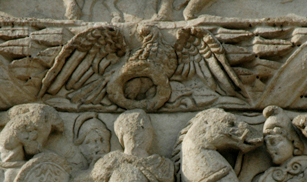
This page created 29 March 2014, and last modified: 29 October 2015 (silver-blue eagle commentary added)

The Constantini seniores is listed (18.20 in Ingo Maier's numbering scheme) as the ninth of the legiones comitatenses under the Magister Militum per Thracias. Its shield pattern (17#4), under the matching label (17.d) Constantini seniores, is shown in various manuscripts as below:

The pattern features a yellow boss (white in W) encircled by a red band, which is in turn encircled by a blue band. The main ground is white, and is charged with a blue bird (white in M, W) standing on the blue band with wings spread, body facing right, and head bent back to the left. The bird appears to be a eagle on O and B, and possibly P (but bereft of its tail), in M it looks more like a magpie, if anything, at least in shape, while the type in W is even harder to discern. The image of an eagle above a central ring (which would thus surround the shield's boss) brings to mind other examples of Roman imagery such as in the Arch of Galerius, where an eagle grasping a wreath of victory is shown over Galerius' (defaced) head:

It may well be that the simple blue ring shown in the surviving Notitia manuscripts was depicted as a wreath in the original compilation. Further, it is likely that what is being shown is not an actual living eagle, or even the divine symbol of Jupiter, but rather the eagle (aquila standard of the unit, since several other shield patterns in the Notitia show unit standards, such as that of the Herculiani iuniores (9.19). In particular, according to Cicero, legionary aquilae standards were made of silver, and the Romans depicted silver with blue when using pigments; a prominent example is the depiction of the aquila in the centre of the breastplate of the well-known Augustus of Prima Porta statue, which was coloured blue when first unearthed, although the colours are now invisible to the naked eye. Thus the Notitia's depiction of the bird being an entirely unnatural blue is very suggestive of a metallic standard and not a feathery bird.
Three other Legiones comitatenses units under the Magister Militum per Thracias, the Tertiodecimani (18.16), the Quartodecimani (18.17), and the Divitenses Gallicani (18.21), have very similar patterns to that of the Quartodecimani, as can be seen below from the following patterns taken from the Paris manuscript:

Given the seemingly unrelated nature of the names of units, this suggests a simultaneous issuance when all four were perhaps detached from their parent units to join a new formation (such as that of the Magister Militum per Thracias).
The name Constantini would appear to derive from either from Constantine I or II, or from a place named after one of these two. Which of these categories the Constantini seniores fits into is unsure - the major Roman city named Contantia (also known as Tomis) is even today Romania's 5th largest city (as Constanta), so a local geographical origin would not be out of place. No unit called the Constantini iuniores is to be found in the Notitia, although there is a Constantini Dafnenses (18.23), which is also listed under the Magister Militum per Thracias. Epigraphic evidence for the Constantini seniores has apparently been found at Odessus (modern Varna in Bulgaria).
1. Ingo Maier; "Appendix 4: Numeration of the new edition of the compilation 'notitia dignitatum' (Cnd)"; last accessed 26 October 2015. See also for here for numbering examples. Return
2. Marcus Tullius Cicero ("Cicero"); "In Catilinam", 1.9.24; available here in Latin and here in English (last accessed 29 October 2015). Return
3. Constantin Bajenaru; "Minor Fortifications in the Balkan Danubian Area from Diocletian to Justinian"; National Museum of Romanian History, The Center for Roman Military Studies, Mega Publishing House, 2010; available here (last accessed 29 October 2015); at p 21. Return

Return to the Notitia alphabetical unit list page.
Return to my Notitia index page.